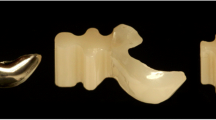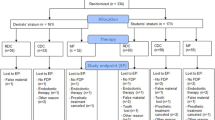Abstract
Objectives
The study evaluated the influence of the number of retention grooves and the retainer wing thickness on the retention of resin-bonded attachments (RBAs).
Methods
Overall, 64 extracted human teeth were prepared, whereby the number of retention grooves (4, 2, 1, or no grooves) and the material thickness (0.7 or 0.5 mm) of the RBAs were varied. This resulted in eight groups with eight specimens each. A sample size of eight specimens per group was chosen because the chewing simulator used for dynamic loading can load eight specimens at a time. After the size of the adhesive area was determined, the abutment teeth were provided with RBAs and subjected to a dynamic loading with thermal cycling. Finally, the failure load was examined using a retention test.
Results
The mean failure loads ranged from 152 ± 50 N to 228 ± 32 N. There had been a significant interaction between the two main factors, i.e., number of retention grooves and material thickness. Neither the number of retention grooves nor the size of the adhesive area had a significant influence on the failure load.
Conclusions
Using a reduced number of retention grooves seems reasonable. However, clinical considerations suggest using two retention grooves to simplify the preparation and bonding procedures.
Clinical relevance
The retention of resin-bonded attachments is promising and supports the clinical application of this minimally invasive treatment modality.





Similar content being viewed by others
References
Zitzmann NU, Hagmann E, Weiger R (2007) What is the prevalence of various types of prosthetic dental restorations in Europe? Clin Oral Implants Res 18(3):20–33. https://doi.org/10.1111/j.1600-0501.2007.01435.x
Zitzmann NU, Rohner U, Weiger R, Krastl G (2009) When to choose which retention element to use for removable dental prostheses. Int J Prosthodont 22(2):161–167
Edelhoff D, Sorensen JA (2002) Tooth structure removal associated with various preparation designs for anterior teeth. J Prosthet Dent 87(5):503–509
Kern M (2005) Einflügelige Adhäsivbrücken und Adhäsivattachments – Innovation mit Bewährung. Zahnärztl Mitt 95(21):2878–2884
Marinello CP, Schärer P, Meyenberg K (1991) Resin-bonded etched castings with extracoronal attachments for removable partial dentures. J Prosthet Dent 66(1):52–55
Marinello CP, Schärer P (1987) Resin-bonded etched cast extracoronal attachments for removable partial dentures: clinical experiences. Int J Periodont Rest Dent 7(2):36–49
Behr M, Leibrock A, Stich W, Rammelsberg P, Rosentritt M, Handel G (1998) Adhesive-fixed partial dentures in anterior and posterior areas. Results of an on-going prospective study begun in 1985. Clin Oral Investig 2(1):31–35
Rammelsberg P, Pospiech P, Gernet W (1993) Clinical factors affecting adhesive fixed partial dentures: a 6-year study. J Prosthet Dent 70(4):300–307
Rammelsberg P, Behr M, Pospiech P, Gernet W, Handel G, Toutenburg H (1995) Extended indication for adhesive restorations as an esthetic and substance-sparing alternative to conventional bridges. Dtsch Zahnärztl Z 50(3):224–227
Nair A, Regish KM, Patil NP, Prithyiraj DR (2012) Evaluation of the effects of different groove length and thickness of the retainers on the retention of maxillary anterior base metal resin bonded retainers—an in vitro study. J Clin Exp Dent 4(2):e91–e96. https://doi.org/10.4317/jced.50714
Emara RZ, Byrne D, Hussey DL, Claffey N (2001) Effect of groove placement on the retention/resistance of resin-bonded retainers for maxillary and mandibular second molars. J Prosthet Dent 85(5):472–478. https://doi.org/10.1067/mpr.2001.114512
Ibrahim AA, Byrne D, Hussey DL, Claffey N (1997) Bond strengths of maxillary anterior base metal resin-bonded retainers with different thicknesses. J Prosthet Dent 78(3):281–285
Kern M, Douglas WH, Fechtig T, Strub JR, DeLong R (1993) Fracture strength of all-porcelain, resin-bonded bridges after testing in an artificial oral environment. J Dent 21(2):117–121
Kern M (2017) RBFDPs: resin-bonded fixed dental prostheses: minimally invasive – esthetic – reliable, 1st edn. Quintessence Publishing, Berlin
Kern M, Thompson VP (1993) Eine einfache Versuchsanordnung zur universellen Prüfung des Klebeverbundes im axialen Zugtest. Dtsch Zahnärztl 48(12):769–772
Kern M, Strub JR, Lü XY (1999) Wear of composite resin veneering materials in a dual-axis chewing simulator. J Oral Rehabil 26(5):372–378
Krejci I, Lutz F (1990) In-vitro test results of the evaluation of dental restoration systems. Correlation with in-vivo results. Schweiz Monatsschr Zahnmed 100(12):1445–1449
Talim ST, Gohil KS (1974) Management of coronal fractures of permanent posterior teeth. J Prosthet Dent 31(2):172–178
Schmitt J, Wichmann M, Eitner S, Hamel J, Holst S (2011) Five-year clinical follow-up of prefabricated precision attachments: a comparison of uni- and bilateral removable dental prostheses. Quintessence Int 42(5):413–418
Passia N, Kern M (2015) Prosthetic treatment concepts for the reduced dentition in German dental schools. Int J Prosthodont 28(4):425–431. https://doi.org/10.11607/ijp.4268
Jagodin S, Sasse M, Freitag-Wolf S, Kern M (2019) Influence of attachment design and material on the retention of resin-bonded attachments. Clin Oral Investig 23(3):1217–1223. https://doi.org/10.1007/s00784-018-2544-5
de Boever JA, McCall WD, Holden S, Ash MM (1978) Functional occlusal forces: an investigation by telemetry. J Prosthet Dent 40(3):326–333
Arola DD, Gao S, Zhang H, Masri R (2017) The tooth: its structure and properties. Dent Clin N Am 61(4):651–668. https://doi.org/10.1016/j.cden.2017.05.001
Zheng Q, Xu H, Song F, Zhang L, Zhou X, Shao Y, Huang D (2013) Spatial distribution of the human enamel fracture toughness with aging. J Mech Behav Biomed Mater 26:148–154. https://doi.org/10.1016/j.jmbbm.2013.04.025
Park S, Quinn JB, Romberg E, Arola D (2008) On the brittleness of enamel and selected dental materials. Dent Mater 24(11):1477–1485. https://doi.org/10.1016/j.dental.2008.03.007
Northeast SE, van Noort R, Shaglouf AS (1994) Tensile peel failure of resin-bonded Ni/Cr beams: an experimental and finite element study. J Dent 22(4):252–256
Acknowledgments
The authors wish to thank the company Kuraray Noritake for the supply of the adhesive material free of charge. Furthermore, the authors wish to thank Mr. Reinhard Busch from the Department of Prosthodontics, Propaedeutics and Dental Materials of the University Medical Center Schleswig-Holstein, Campus Kiel, for his continuous impetus.
Funding
The work was supported by the Department of Prosthodontics, Propaedeutics and Dental Materials, School of Dentistry, Christian-Albrechts University of Kiel, Kiel, Germany.
Author information
Authors and Affiliations
Corresponding author
Ethics declarations
Conflict of interest
The authors declare that they have no conflict of interest.
Ethical approval
This article does not contain any studies with human participants or animals performed by any of the authors.
Informed consent
For this type of study, formal consent is not required.
Additional information
Publisher’s note
Springer Nature remains neutral with regard to jurisdictional claims in published maps and institutional affiliations.
Rights and permissions
About this article
Cite this article
Brune, J., Wille, S. & Kern, M. Influence of the preparation form on the retention of resin-bonded attachments for removable dental prostheses. Clin Oral Invest 24, 3307–3313 (2020). https://doi.org/10.1007/s00784-020-03208-5
Received:
Accepted:
Published:
Issue Date:
DOI: https://doi.org/10.1007/s00784-020-03208-5




